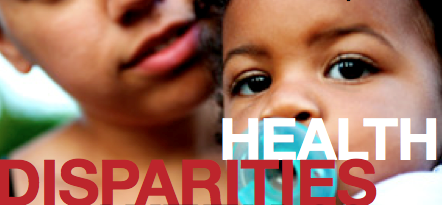 Research has documented a number of racial disparities in health care, including higher death rates among African-Americans than whites. New government data shows some significant improvements.
Research has documented a number of racial disparities in health care, including higher death rates among African-Americans than whites. New government data shows some significant improvements.
The study from the Centers for Disease Control and Prevention found African Americans are living longer. The death rate for African Americans has declined about 25% over 17 years, primarily for those aged 65 years and older.
However, younger African Americans are living with or dying of many conditions typically found in white Americans at older ages.The difference shows up in African Americans in their 20s, 30s, and 40s for diseases and causes of death.
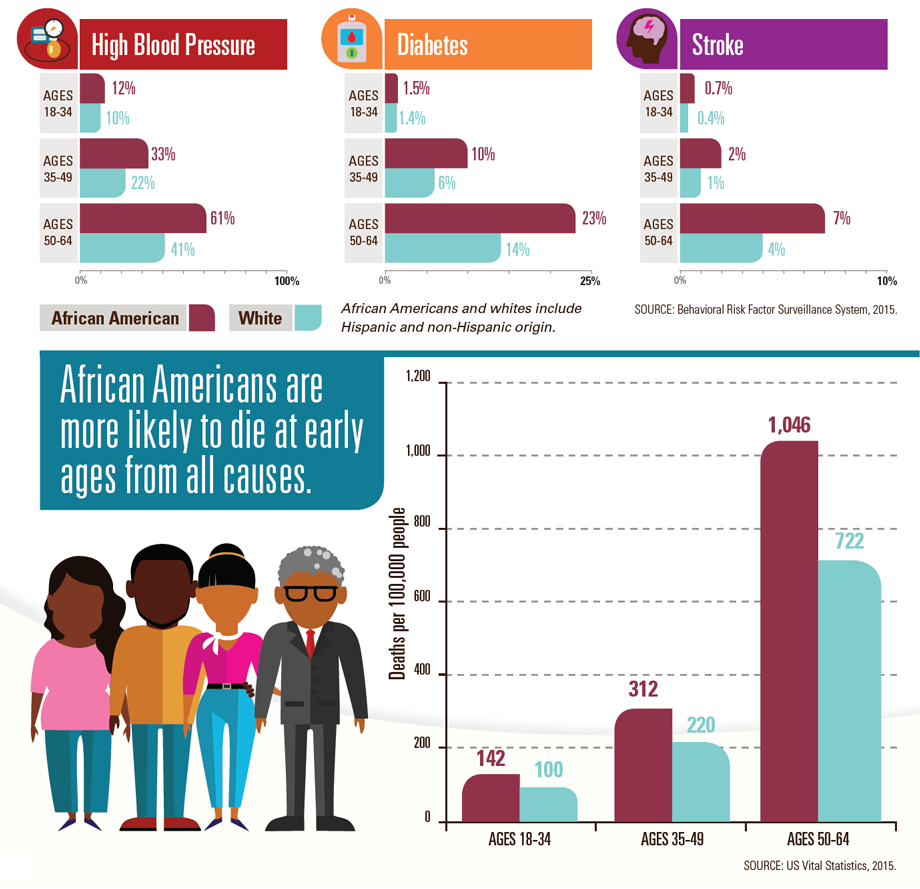
Chronic diseases and some of their risk factors may be silent or not diagnosed during these early years. Health differences are often due to economic and social conditions that are more common among African Americans than whites. For example, African American adults are more likely to report they cannot see a doctor because of cost. All Americans should have equal opportunities to pursue a healthy lifestyle.
According to the 2016 National Healthcare Quality and Disparities Report, some disparities were getting smaller from 2000 through 2014-2015, but disparities persist, especially for poor and uninsured populations in all priority areas:
- While 20% of measures show disparities getting smaller for Blacks and Hispanics, most disparities have not changed significantly for any racial and ethnic groups.
- More than half of measures show that poor and low-income households have worse care than high-income households; for middle-income households, more than 40% of measures show worse care than high-income households.
- Nearly two-thirds of measures show that uninsured people had worse care than privately insured people.
It is important to create opportunities for all Americans to pursue a healthy lifestyle. What can be done?
The Federal government is
- Collecting data to monitor and track health and conditions that may affect health, such as poverty and high school graduation rates, through Healthy People 2020. http://bit.ly/2oDhWV4
- Supporting partnerships between scientific researchers and community members to address diseases and conditions that affect some populations more than others.
- Addressing heart disease, stroke, and other cardiovascular diseases, which disproportionately affect African Americans, by implementing national initiatives such as Million Hearts®. http://bit.ly/2p0Ux0N
- Supporting actions to create healthy food environments and increase physical activity in underserved communities.
Public health professionals can
- Use proven programs to reduce disparities and barriers to create opportunities for health.
- Work with other sectors, such as faith and community organizations, education, business, transportation, and housing, to create social and economic conditions that promote health starting in childhood.
- Link more people to doctors, nurses, or community health centers to encourage regular and follow-up medical visits.
- Develop and provide trainings for healthcare professionals to understand cultural differences in how patients interact with providers and the healthcare system.
Community organizations can
- Train community health workers in underserved communities to educate and link people to free or low-cost services.
- Conduct effective health promotion programs in community, work, school, and home settings.
- Work across sectors to connect people with services that impact health, such as transportation and housing.
- Help people go see their doctor, take all medications as prescribed, and get to follow-up appointments.
Healthcare providers can
- Work with communities and healthcare professional organizations to eliminate cultural barriers to care.
- Connect patients with community resources that can help people remember to take their medicine as prescribed, get prescription refills on time, and get to follow-up visits.
- Learn about social and economic conditions that may put some patients at higher risk than others for having a health problem.
- Collaborate with primary care physicians to create a comprehensive and coordinated approach to patient care.
- Promote a trusting relationship by encouraging patients to ask questions.



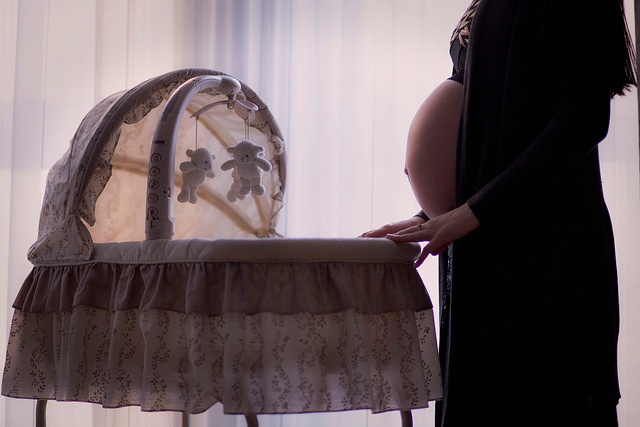 ProPublica and NPR launched a project about maternal deaths and near-deaths in the U.S. In recent months, mothers who nearly died in the hours and days after giving birth have repeatedly
ProPublica and NPR launched a project about maternal deaths and near-deaths in the U.S. In recent months, mothers who nearly died in the hours and days after giving birth have repeatedly 



 You might be a recent graduate and are worried about what to do when you get a difficult patient or maybe you are an experienced Nurse and are looking for new tips or ideas to try. We created a list of ways Nurses avoid or diffuse challenging situations with patients.
You might be a recent graduate and are worried about what to do when you get a difficult patient or maybe you are an experienced Nurse and are looking for new tips or ideas to try. We created a list of ways Nurses avoid or diffuse challenging situations with patients. For 14 years, MultiCare hosts a week-long Nurse Camp in the Summer for students who want to work in the medical field. Since there will be a growing demand for Nurses as baby boomers retire and leave the field, this program helps students get a head start on experience and learning.
For 14 years, MultiCare hosts a week-long Nurse Camp in the Summer for students who want to work in the medical field. Since there will be a growing demand for Nurses as baby boomers retire and leave the field, this program helps students get a head start on experience and learning.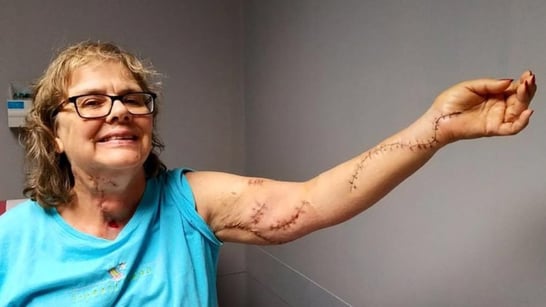 Nurse Elise Wilson was in critical but stable condition after being stabbed by a patient at Harrington Hospital in Southbridge last month. Nurses aren't "expecting to encounter violence but they do, every single day of the week," said Elise's husband,
Nurse Elise Wilson was in critical but stable condition after being stabbed by a patient at Harrington Hospital in Southbridge last month. Nurses aren't "expecting to encounter violence but they do, every single day of the week," said Elise's husband,  For many people, Nursing was all they ever imagined they would be doing as their career. For other people, becoming a Nurse was a second career for them. No matter which stage in life they chose to become a Nurse, these people are passionate about what they do and they are happy they made the switch to a job they love.
For many people, Nursing was all they ever imagined they would be doing as their career. For other people, becoming a Nurse was a second career for them. No matter which stage in life they chose to become a Nurse, these people are passionate about what they do and they are happy they made the switch to a job they love.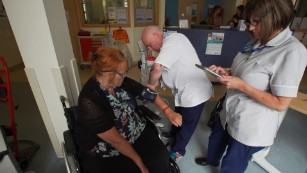 John McElroy worked in a local brick factory for about twenty-five years. He lost his job in 2007 after sufferring from a stroke. McElroy wanted to be a Nurse when he was younger and during one of his hopsital visits, his childhood dream was restored. John told
John McElroy worked in a local brick factory for about twenty-five years. He lost his job in 2007 after sufferring from a stroke. McElroy wanted to be a Nurse when he was younger and during one of his hopsital visits, his childhood dream was restored. John told .jpg?width=307&name=1473958826-NSL_29NURSE01_51885364-(2).jpg) When Bob Evans was 20 years old he took an aptitude test that showed Nursing as a good match for him. Learning news that he was going to become a father Bob decided to take a job in the horticulture business, mostly in sales and customer-service positions in landscaping and lawn care.
When Bob Evans was 20 years old he took an aptitude test that showed Nursing as a good match for him. Learning news that he was going to become a father Bob decided to take a job in the horticulture business, mostly in sales and customer-service positions in landscaping and lawn care.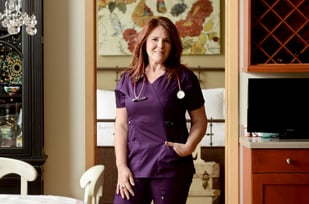

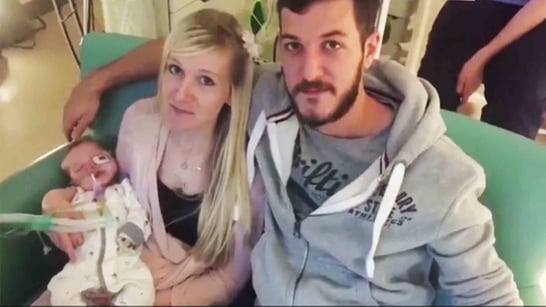 I've read many articles discussing cases of euthanasia, the use of life support, and Death with Dignity. This case involves the life of an 11-month-old boy named Charlie Gard. Charlie's parents, Chris Gard and Connie Yates, are trying to prevent Doctors in London from turning off their son's life support so they can take him to the United States for an experimental treatment. Charlie has a rare degenerative condition called Mitochondrial DNA depletion syndrome.
I've read many articles discussing cases of euthanasia, the use of life support, and Death with Dignity. This case involves the life of an 11-month-old boy named Charlie Gard. Charlie's parents, Chris Gard and Connie Yates, are trying to prevent Doctors in London from turning off their son's life support so they can take him to the United States for an experimental treatment. Charlie has a rare degenerative condition called Mitochondrial DNA depletion syndrome.